Patient Perceptions of the Use of Medical Marijuana in the Treatment of Pain After Musculoskeletal Trauma: A Survey of Patients at 2 Trauma Centers in Massachusetts
To evaluate musculoskeletal trauma patients’ beliefs regarding the usefulness of marijuana as a valid medical treatment for postinjury and postoperative pain and anxiety. The majority of patients in this study believed that medical marijuana is a valid treatment and that it does have a role in reducing postinjury and postoperative pain. Those patients who used marijuana during their recovery felt that it alleviated symptoms of pain and reduced their opioid intake.


